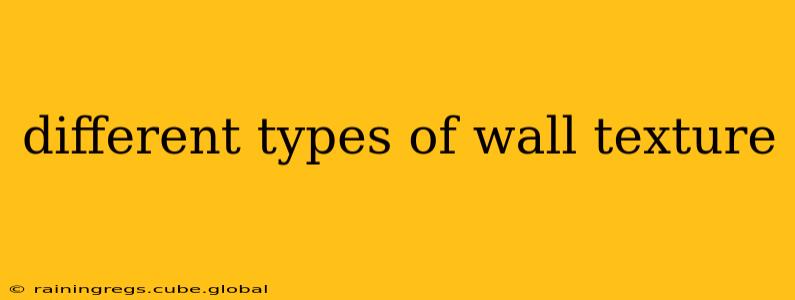Choosing the right wall texture can dramatically impact the look and feel of your home. From subtle sophistication to bold statements, the options are vast and varied. This guide explores the different types of wall textures, their applications, and the pros and cons of each, helping you make an informed decision for your next project.
What are the Different Types of Wall Textures?
Wall textures are created through various methods, resulting in a wide array of finishes. These can be broadly categorized into several types:
1. Smooth Textures:
These offer a clean, minimalist aesthetic, perfect for modern or contemporary styles. They are typically achieved with carefully applied plaster or drywall compound, followed by sanding for a flawless finish.
- Pros: Easy to clean, provide a sleek, uncluttered look, visually enlarge smaller rooms.
- Cons: Show imperfections more readily, can feel sterile without added elements.
2. Lightly Textured Walls:
These offer a slightly uneven surface, adding subtle visual interest without being overly dramatic. Popular options include:
- Orange Peel: A very fine, speckled texture, reminiscent of its namesake. It's easy to apply and hides minor wall imperfections well.
- Popcorn/Acoustic Texture: A more pronounced, heavily textured finish that was once very popular for its sound-dampening qualities. Removal can be messy and labor-intensive.
- Knockdown Texture: Created by applying a heavier coat of joint compound and then "knocking down" the peaks with a specialized tool, leaving a slightly rough finish.
Pros: Mask minor wall imperfections, offer moderate sound absorption (especially popcorn texture), relatively easy to clean. Cons: Popcorn texture contains asbestos in older homes (test before removal!), can trap dust and allergens.
3. Heavily Textured Walls:
These create bold, dramatic visual impact. Examples include:
- Sand Texture: A rough, sandy finish, often achieved by applying a textured paint or specialized coating.
- Stucco: A traditional exterior finish, but can also be used indoors for a rustic or Mediterranean feel. It's incredibly durable and requires minimal maintenance.
- Venetian Plaster: A luxurious, highly polished finish that resembles marble. It's a complex application process, requiring skilled craftsmanship.
Pros: Create a strong visual statement, highly durable (especially stucco), can add depth and character to a room. Cons: Difficult to clean, can be expensive (especially Venetian plaster), may not be suitable for all interior styles.
What is the Best Wall Texture for Hiding Imperfections?
Heavily textured walls, such as knockdown or sand texture, are best at hiding imperfections in the underlying wall surface. However, orange peel texture provides a good balance between hiding minor flaws and maintaining a relatively smooth surface. Remember that extremely heavy textures might highlight larger structural issues.
What are the Most Popular Wall Textures?
Popularity varies by design trends, but consistently popular choices include orange peel, knockdown, and lightly textured finishes due to their ease of application, ability to hide imperfections, and versatility in different interior styles.
How Do I Choose the Right Wall Texture for My Home?
The best wall texture depends on several factors:
- Your personal style: Consider the overall aesthetic of your home and the mood you want to create.
- The room's function: A smooth texture might be better suited for a bathroom, while a heavily textured finish could add warmth to a living room.
- Your budget: Some textures, like Venetian plaster, are far more expensive than others.
- The condition of your walls: If your walls have imperfections, a textured finish can help to camouflage them.
By carefully considering these aspects, you can choose a wall texture that perfectly complements your home and enhances its beauty. Remember to consult with a professional for complex textures like Venetian plaster or when dealing with potentially hazardous older finishes like popcorn ceilings.
